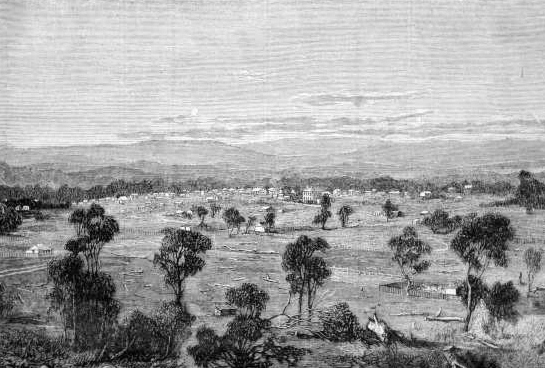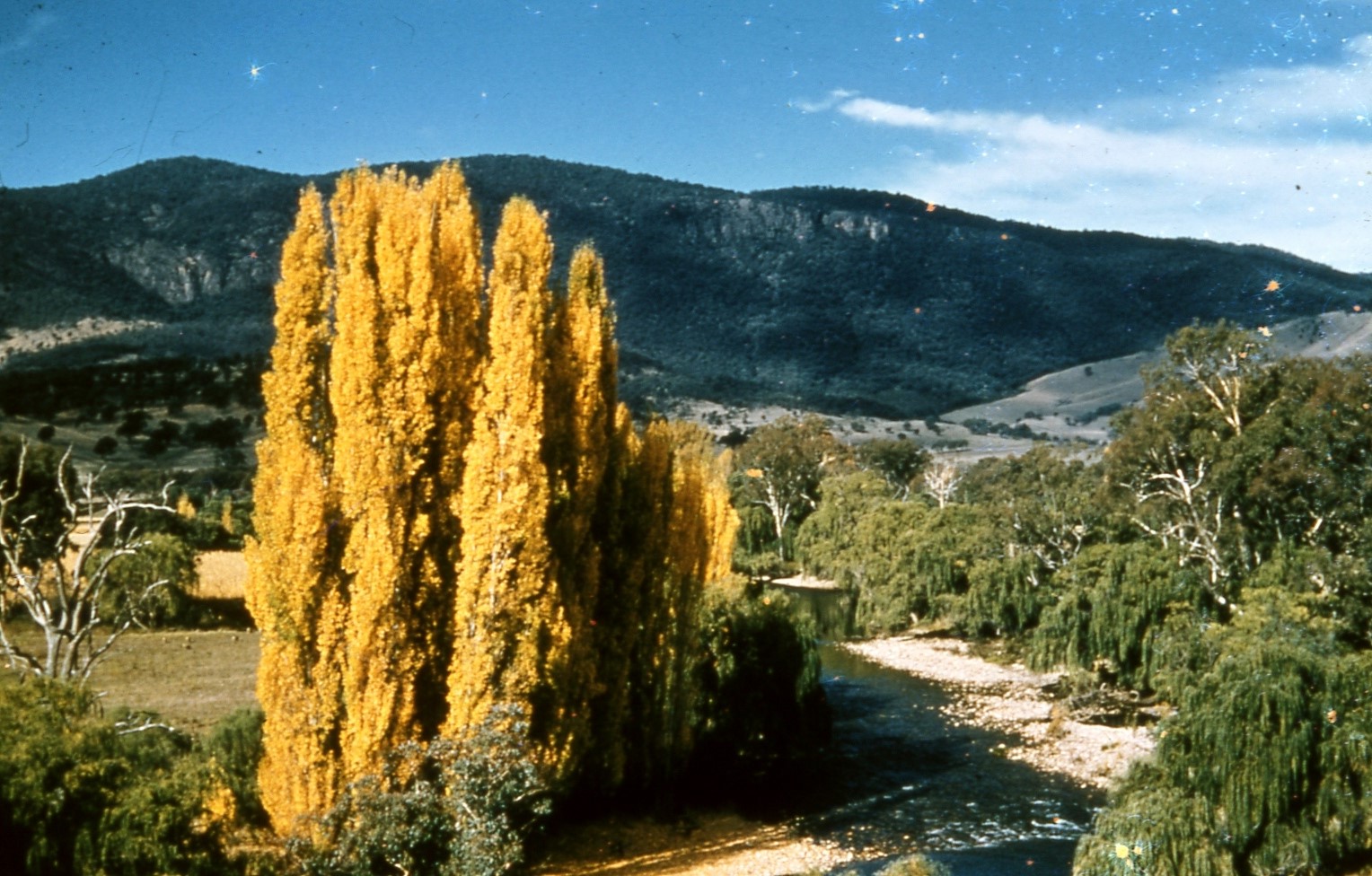Map Darbalara
Another was a Mr Warby who settled at 'Darbalara'
"Darbalara"
on the Murrumbidgee and Tumut Rivers. It is known that on 27 November, 1828 the explorer Charles Sturt
Captain Charles STURT
(on one of his many unsuccessful missions to find Australia's 'inland sea') stopped at Warby's house. It was here that Elizabeth Warby was born on 10 May, 1830 - probably the first European to be born in the valley.
Early Tumut
Tumut Town - About 1872


The township grew slowly. Squatters were well established in the valley but by 1856 the town was nothing more than a single school building, a few mud and slab huts and three hotels. The town had been surveyed, and laid out in a classic grid pattern, as early as 1848 but it was only a major flood in 1852 which finally persuaded the locals to form some kind of a town.
By 1860 the town had grown to a point where it a local newspaper which eagerly reported that the local cricket club was holding annual meetings and the cricket played on the town's racecourse was so popular that three publicans' booths were provided (the publicans had to pay a guinea for the priviledge) to quench the thirst of the players and spectators. After the game the players headed for the Woolpack Hotel for more drinking.
The Goldrush era saw the rapid development of the town. At one stage in 1860 there was a report of over 1200 men passing through Tumut in the space of four days as they headed to the Kiandra goldfields. With gold came the bushrangers. The town's one bushranger was William Brookman, a carpenter by trade, who joined the infamous 'Blue Cap' gang. But the the most famous bushranger to work in the area was James Kelly (brother of Ned) who, in 1877, stole some horses in Wagga which they later tried to sell in Tumut.
The post-goldrush period, which had seen people moving through the area to the
Adelong
and Kiandra goldfields, saw a small boom in the town's fortunes. By 1866 the number of pubs had grown to eleven and this had expanded to 18 pubs by 1880. Today the town has only six pubs. It became a municipality in 1887 and the Tumut Shire, including Batlow and Adelong was created in 1928.
Oriental Hotel - Cnr Fitzroy and Wynyard St's, Tumut.

The Oriental Hotel was originally known as the Queens Arms. It is a typical goldrush era building showing off its affluence. There was a pub on this site as early as 1850 and the first publican was a man named Madigan. This new hotel was designed and built by Frederick Kinred about 1876. He took up Madigan's license. It has a beautiful cast iron verandah.
Bank Corner

The corner of Wynyard and Russell Streets is bank corner with the old Bank of New South Wales (now Westpac), which was built in 1891, on the south west corner. A managers residence was built on the first floor.
 Tumut CBC Bank - Wynyard St & Russell St's
Tumut CBC Bank - Wynyard St & Russell St's
CBC Bank (now the National) built in 1889 on the north eastern corner. It also had a managers residence built above. The old Bank of New South Wales is a late Victorian Free Classical building characterised by a two-storey arcaded verandah and Ionic pilasters. The hipped corrugated iron roof is topped by three large chimneys. The old CBC bank is a Victorian Classical Revival designed by the Mansfield brothers. The verandah is supported by fluted cast-iron columns and there are attractive French windows on the first floor.
 The Commonwealth Bank is also in Wynyard Street on the northern side between Russell and Fitzroy Street's. It also had a managers residence built on the first floor.
The Commonwealth Bank is also in Wynyard Street on the northern side between Russell and Fitzroy Street's. It also had a managers residence built on the first floor.
Rotary Lookout

Continue up Wynyard Street. At the top there is an excellent view across the town and the Tumut River to Bombowlee.
photo
Tumut Museum
Place photo
Located in Capper St, the Tumut Museum holds a good display of memorabilia about the local area. It is open Saturdays and Wednesdays from 2.00 p.m. to 4.00 p.m. and at other times by arrangement, tel: (02) 6947 2183, (02) 6947 6731 or (02) 6947 1380.
Pioneer Cemetery
Place photo

Beyond the Roman Catholic Church, cross over the Highway (Adelong Road), following Gocup Rd for a short distance
then turn left into a driveway that leads directly to the town's Pioneer Cemetery. The most notable gravestones are those of Thomas Boyd who travelled from Sydney to the present day site of Melbourne with the explorers Hume and Hovell. Also of interest is the grave of the talented Aboriginal cricketer Johnny Taylor who died of measles in 1875. He worked as a stockman at Blowering and was known as the best cricketer in the district before his untimely death. He was in his 20s when he died.
Pioneer Park
Place photo
Located opposite the town's swimming pool, and adjacent the Tumut River, this is a beautiful rural retreat with fine displays
of European deciduous trees which are shady in the summer months and spectacular during autumn. There are plenty of park benches for picnics and a pleasant stream winds through the centre of the park.
Stockwell Gardens

Situated around the intersection of Richmond and Russell Streets, the trees have botanical name plates in this award-winning garden.
River Walk
 A pleasant walk by the Tumut River.
A pleasant walk by the Tumut River.
The Visitors centre has a book available outlining a tree walk. It focuses on the trees from Bungle Rd, along the river
to Pioneer Park, taking in Stockwell Gardens.
Elm Drive

Sometimes referred to as the 'Avenue of Elms' this is a spectacular and pleasant walk in any season but is most impressive in spring and autumn when the trees are thick with leaves. It leads down to the old racecourse and further on is the original site of the township which was destroyed by a flood in 1852.
Tumut Broom Factory
Place photo

Millet brooms are still handmade at the Tumut Broom Factory which is located on Adelong Road (ask at the Visitor Centre
for directions) and is open from 8.30 a.m. to 4.30 p.m. on weekdays (closed for lunch). There is no entry fee and no bookings
are necessary, except for coaches tel: (02) 6947 2804.
Tumut Valley African Violets Farm

With over 950 named varieties it is reputedly the largest African violet farm in Australia. Located in the grounds of the
120-year-old Tumut Plains School House. It is located 7 km from Tumut on Tumut Plains Rd and offers morning and afternoon
teas at the Garden Cafe. In summer, and on school and public holidays, it is open daily from 10.00 a.m. to 5.00 p.m.,
closing at 4.00 p.m. in winter. There is no entry fee and no bookings are necessary, except for coaches. For more information
contact the owners on (02) 6947 2432.
Boonderoo Wines
Situated on Boonderoo Road (off the Snowy Mountain Highway to the south of town), this small winery is open for tastings and cellar door sales most weekends and at other times by arrangement, tel: (02) 6947 2060.
Bonnie B's Shaker Shed
Place photo
This eccentric collection of over 3000 salt and pepper shakers can be seen by groups or coach groups for an individual entry fee of $2. Located 2.5 km from the main street via the Snowy Mountains Highway (just across Currawong Rd) they are open most days from 10.00 a.m. to 5.00 p.m., tel: (02) 6947 2060.
Blowering Dam

Take the Snowy Mountains Highway out of town, heading towards Cooma and follow the signs to the Blowering Dam. The journey is 12 km. The dam is impressive with the wall being over 120 metres high. It has the second largest storage capacity in the whole Snowy Mountains project. The dam was the site where the world's longest water-ski run occurred when someone kept going for 1673 km. It also became the location of the world water-ski record when Ken Warby travelled across it on skis at 510.45 km/hour in 1978.
Snowy Mountains Trout Farm

Situated on the Old West Blowering Road, just south from Oddy's Bridge
Located below the Blowering Dam wall, the trout farm, touted as NSW's largest, is open daily from 9.00 a.m. to 3.00 p.m. for fish sales. Self-guided tours are available on weekends for a small fee, tel: (02) 6947 3612.
Bushwalking

Camp site - during a Long Bush Walk.
There are a large number of tracks in the area many of which are now part of the Hume and Hovell Walking Track. The most impressive is the 18 km Thomas Boyd Track which crosses valleys on swing bridges. Information about the tracks, including detailed topographical maps, can be obtained from the Tumut Visitors Centre, tel: (02) 6947 7025.
1924 - HUME-HOVELL MEMORIAL Sydney, Saturday.
Sir George Fuller, the Premier, and Sir Austin Chapman at Gunning yesterday unveiled a column with a tablet at FISh River in connection with the Hume-Hovell centenary, and laid a foundation stone of the literary instituto and museum for old relics and
war trophies. - (Ref- Barrier Miner (Broken Hill, NSW : 1888 - 1954)(about) Previous issue Saturday 18 October 1924_.
Poplars touched by autumn colours in the Tumut Valley

Davis view looking north from West Blowering Road
Festival of the Falling Leaf.
There is a widely accepted view that autumn in Tumut offers the most spectacular display of 'colours' anywhere in New South Wales. In the 1950s the local headmaster, Alf Woods, instituted the idea of a Festival to celebrate the arrival of autumn and the falling leaves which characterised the town's many parks and gardens. It has become a hugely popular event and is held each year in April-May. Contact (02) 6947 7025 for more information.
Rotay Diary
Place photo
Have you ever seen a Rotary Diary working before? Visitors can view one working at the 3 p.m. milking at this dairy on Tumut Plains Rd, Tumut - just telephone (02) 6947 1905 to make arrangements.
Hang Gliding

Blowering - view from a Glider
"Air Escape" offer powered hang glider flights from Tumut Aerodrome on Brungle Road. They operate daily and offer a trial introductory half-hour flight,
This report is submitted in good faith. All endeavours have been made to make all entries authentic and correct. For any corrections and additional valuable information, maps and photos you may have please contact John
To Home page


























